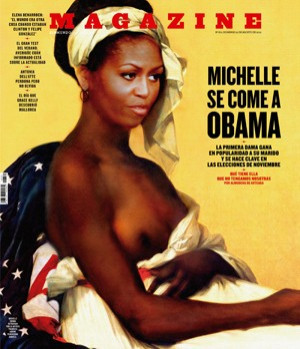Obama Cartoon Controversy Surrounds Louisiana Teacher, And Spanish Magazine

Good political cartoons can be hilarious. Bad political cartoons can cause a big, big controversy.
Just ask Louisiana teacher Robert Duncan and perhaps the editors of the Spanish magazine Fuera de Serie. Cartoons from both, depicting the Obamas, have been thrust into the spotlight this week for what some believe are offensive pictures of the United States president and the first lady.
Duncan, a 55-year-old social studies teacher at Boyet Junior High, is fighting to win his job back after his issuing a political cartoon assignment to seventh graders in January led to several rabble-rousing pictures - one of which shows the president with what appears to be a bullet wound to the temple and another stating "Open Season" under a likeness of Obama.
The controversial cartoons made headlines when a parent snapped cellphone pictures and released them to the media. The embattled teacher was placed on paid leave and then fired on Aug. 6. He got a chance to defend himself Wednesday in a public hearing where his attorneys and the school board argued that things were blown out of proportion and that Duncan, who has worked at the school since 1999, was wrongfully terminated.
The Times-Picayune reported that a student responsible for the artwork wrote a letter explaining she dropped a marker on the photo the night before she was to turn in her assignment, and didn't have time to fix the smudge.
"She was cramming to get the assignment done, and sadly, in the process (she) knocked over a marker that caused the mark to be made," Harry Pastuszek, the school board's lead attorney, said. "Efforts were made to remove the mark, efforts were made by the student to camouflage and cover up the mark, but unfortunately it was not possible to be done on account of the construction paper and the wicking of the glue underneath with the marker."
Recommendations will be made to St. Tammany Parish Public Schools Superintendent Trey Folse to reverse, amend or uphold the decision to fire Duncan.
While the issue of political cartoons may have a racial undertone in the Louisiana case, it wasn't so for the Spanish magazine, which sees it as art.
The article that accompanied the cover photograph of Michelle Obama's face photoshopped onto the famous painting "Portrait d'une négresse" -- by French artist Marie-Guillemine Benoist, painted in 1800 -- praised the first lady as a great woman.
The French painting, which shows a black woman wearing a head wrap and one breast exposed, is said to be a symbol of women's emancipation and black rights. It was completed six years after that nation's leaders abolished slavery. Yet, it adheres to a stereotypical image of black-skinned people, popular in European art at the time, but which has since been outmoded by a far different consciousness.
The article, according to the magazine's website, promises to tell how Michelle won not only Obama's heart but that of the American people also.
Though the story is a positive, to some the distorted image of the U.S. first lady dressed in essentially the wardrobe of a slave, and in any case partially disrobed, is to put it mildly not art at all. Some have even questioned if the magazine cover is racist.
Althea Legal-Miller wrote in Clutch magazine, "The portrait robs Obama of her identity, voice, and intellect, and visually shackles her to a politically passive subject, resigned to an assigned role as slave. I do not support the censorship of art. However, the mass reproduction of this nude portrait on the cover of a national newspaper supplement is a legitimate concern. Of all the stock images that might have been pulled for the cover, I find the editorial decision to portray Obama as the embodiment of enslavement and colonization extremely troubling. This is all the more perplexing given that this image severely undermines the cover story article, which acknowledges the political significance of Obama and champions her intuitive and intellectual prowess. So sad, then, that this image has in some way become a part of the Spanish popular imaginary."
© Copyright IBTimes 2024. All rights reserved.






















